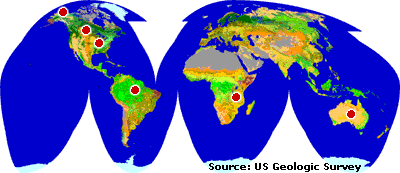|
There are many different
kinds of plants and animals on the Earth, but only certain kinds
are naturally found at any particular place. (We are not counting
zoos here!) For example, cacti are found in the desert, polar bears
are found in the Arctic, and elephants are found in central Africa
and India. So, why don't people living in south Texas have to be
on the lookout for snow leopards, or why don't kids in Minnesota
have to worry about finding giant boa constrictors in their back
yards? It is because these animals are not adapted to live in the
average weather conditions found in Texas or Minnesota.
These average weather
conditions, such as the range of temperature and rainfall that typically
occur in a particular location like Minnesota, are called the climate
of that location. Some climates are hot, some are cold, some are
wet and some are dry. "Adapted" means that a plant or animal has
inherited certain characteristics that enable it to live in one
type of climate or another. For example, polar bears have a layer
of fat under their skin and a heavy fur coat to help them withstand
arctic cold. They would have a difficult time trying to survive
in a hot climate.
Plants and animals don't
live in isolation, but they live together with other plants and
animals in an interdependent group called an ecological community.
If you think about it for a moment, you will realize that all of
the plants and animals in a particular ecological community must
be adapted to the same climate so that they can all live in the
same location.

A distinct ecological
community of plants and animals living together in a particular
climate is called a "biome." Scientists have divided the broad
spectrum of climates and ecological communities found on Earth
into biomes in different ways - some with many divisions, some
with only a few. Here is a commonly found grouping:
The locations of these
different biomes across the face of Earth are shown in different
colors in the map* above. The Arctic tundra is light tan (ice
is white). Mid-Latitude deciduous forests are greenish-yellow
and yellowish-green. Deserts are mostly gray. Tropical rainforests
are green. Tropical savannahs are light green and dark yellow.
Areas of taiga are dark green and gray-green. To find out more
about each of the biomes, just click on one of the spots on the
map or use the navigational bar at the right of the page.
*Map
was made from thousands of satellite images taken between April
1992 and March 1993 using a scanning device called the: Advanced
Very High Resolution Radiometer aboard TIROS series satellites.
Map courtesy of the USGS.
Next
|











